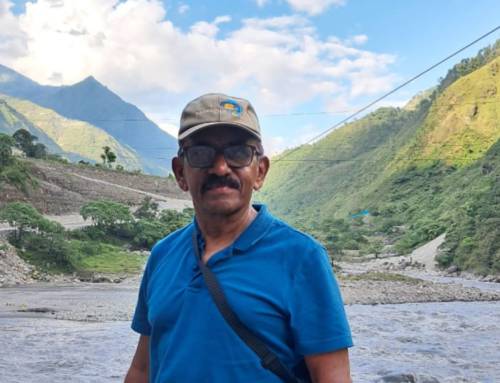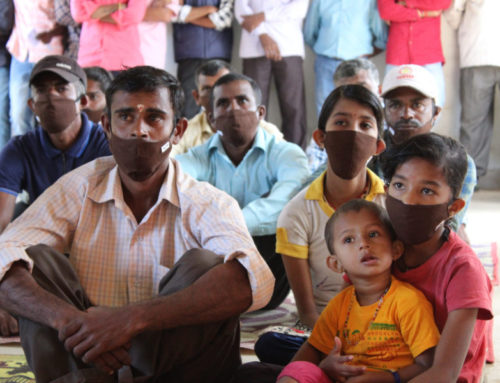Authors: Dr. Krithi K. Karanth and Priyadarshini D.
Thirty-year-old Mahadevamma set out one morning with her aging mother to pick cotton in the family’s one acre plot. Her husband, a farmer and migrant laborer, was away. The daily wage labourers her family hired for help had failed to turn up. Her village of Doddabargi lies on the fringes of Bandipur National Park and Tiger Reserve. Her own plot stretches close to the boundary of the park. Bandipur is a well known protected area in the southern state of Karnataka in India. Often cited as an example of conservation success, it is home to many charismatic and endangered megafauna such as tigers, leopards, and Asian elephants. After a few hours of picking cotton, she chanced upon the carcass of a dead calf, still oozing blood: a fresh kill. Just as she turned around, shouting for her mother, a tiger grabbed her by the shoulders, obscured until then by the tall cotton plants. Mahadevamma had unwittingly disturbed the big cat’s lunch. A tussle ensued next between the tiger and her mother, who held onto Mahadevamma’s hands. The arrival of neighboring farmers, alerted by their screams, prompted the tiger to abandon its half eaten kill and run into the forest. Mahadevamma sustained severe injuries to her arms and back. She also bears emotional scars– she is afraid to go back to her field to work.

Mahadevamma, receiving treatment in the hospital for her injuries. With her husband away as a migrant labourer, Wild Seve stepped in promptly to immediately document her injuries and file for compensation on her behalf.
Nanjundappa resides in the village of Chennamallipura, in the Maddur range of Bandipur, with his wife and two young daughters. He owns a two acre plot that skirts the national park. Thick clumps of lantana dot the corners of the adjoining fields, providing effective cover to animals and birds. One evening, as he was walking home after a hard day’s work in the fields, he ran into a startled wild pig rummaging in one such lantana clump. The pig wounded Nanjundappa’s knees with its tusk. Injured and in shock, it was a full half hour before he could collect himself to call in a friend for help. His injuries will put him off work for nearly a month at a crucial time – his seedlings require fertilizers and constant care. As a marginal farmer, he cannot afford to hire laborers to go in his stead. His crops will suffer as a result of his injury with consequences to his family’s quality of life, especially, his indebtedness outside formal banking channels at usurious interest rates.
While conflict incidents represent risks associated with living in close quarters with wildlife, they also highlight the chance nature of encounters with wildlife in the fringes of national parks and tiger reserves. For the over 600 settlements located around Bandipur and Nagarahole national parks and tiger reserves, some interactions with India’s diverse and charismatic wildlife are inevitable. Many farmers attest to the near ubiquity of wild pigs in their villages and farms. Elephants come in next, with several other species like peacocks, deer, canids, and hares also occasionally visiting the fields and villages, although the forest department had extensively built trenches and railway fencing along park boundaries. Big cats are sighted too, although rare. Sometimes, these encounters turn into conflict with dire consequences for both humans and the animal.

Nanjundappa’s encounter with a wild pig and the resulting injuries also reverberate within the family – his wife, who often supports him, is now afraid to step into their field.
Fortunately though, cases of human injury and death due to wildlife constitute only a small portion of the human wildlife conflict cases. In 2012-13 – the year for which complete data is available – out of a total of 78,656 incidents of crop loss, property damage, human death and injury, India reported 5185 cases of human injury or death due to wildlife from 18 states. India paid a total of $5.3 million as compensation during this period. Karnataka is one of the twenty seven states in India which provide compensation for human injury or death from conflict with wildlife. In 2012-2013, Karnataka reported one of the highest losses at 59 people dead and another 187 injured in conflict incidents, with a total of $454,935 being paid out as compensation (Karanth et. al., 2018; in press, Biological Conservation).
Incidents of human death and injury in particular also ignite passionate responses: anger, mob scenes, and demands for vengeance or retaliation. A few years ago, human deaths caused by an injured tiger led to altercations between a furious and scared village of Chikkabargi and the forest department. The village burned down the forest department’s office in anger after a resident was killed by the tiger. When the animal was finally caught, the mob demanded the animal be set ablaze. It was in one such situation that Wild Seve field assistant Mahadevaswamy found himself in the initial year of Wild Seve. Mistaken for forest department staff, he also received a few choice blows from angry locals. Undaunted though, he and his colleagues continue to attend to cases of human death and injury.

Physical incapacitation of earning members in a family resulting from conflict injuries impose severe economic and emotional burden.
Recently, when Cheluva from Doranakatte Colony in the Hediyala range of the park was injured by a wild pig, he reached out directly to Mahadevaswamy. Typically, the injured or the victim’s family call the forest department first, who usually respond with alacrity. The department in turn requests Wild Seve for assistance with documenting injuries and filing for compensation. When Cheluva called, Mahadevaswamy immediately advised him to obtain treatment in a hospital first and to track and collect all his medical bills when discharged.
Such guidance and support towards the victims and the forest department is instrumental in relieving traumatized victims or grieving families at a time when matters like documentation and compensation claims are furthest from their mind. Matters which are essential for their subsequent relief, in the form of government mandated compensation. Although nothing can substitute for the loss of physical abilities, or death of a loved one, Wild Seve endeavours to help people tide over a difficult phase of their trauma, and in a small way, enable traditionally nature loving people to retain their relationship with it.
Scientific Reference:
Karanth, K. K., Gupta, S., Vanamamalai, A., 2018. Compensation payments, procedures and policies towards human-wildlife conflict management: Insights from India. Biological Conservation (doi:10.1016/j.biocon.2018.07.006)






